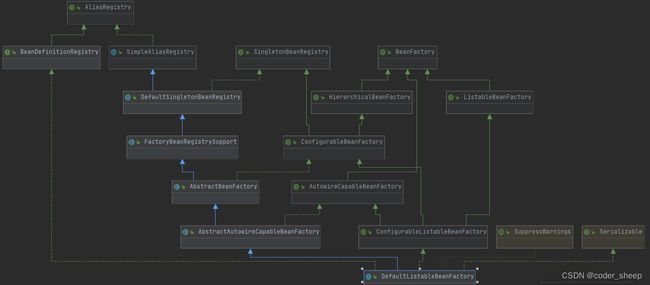Spring源码学习-Spring流程概述(一)
Spring启动的流程
public class Test {
public static void main(String[] args) {
ClassPathXmlApplicationContext context = new ClassPathXmlApplicationContext("applicationContext.xml");
Student bean = context.getBean(Student.class);
context.close();
}
}
调用本类的构造方法
public ClassPathXmlApplicationContext(
String[] configLocations, boolean refresh, @Nullable ApplicationContext parent)
throws BeansException {
// 调用父类构造方法,进行相关的对象创建等操作,包含属性的赋值操作
super(parent);
//设置应用程序上下文的配置路径
setConfigLocations(configLocations);
if (refresh) {
refresh();
}
}
这个refresh方法包含了spring的启动核心流程
public void refresh() throws BeansException, IllegalStateException {
synchronized (this.startupShutdownMonitor) {
// Prepare this context for refreshing.
/**
* 做容器刷新前的准备工作
* 1、设置容器的启动时间
* 2、获取Environment对象,并加载当前系统的属性值到Environment对象中
* 3、准备监听器和事件的集合对象,默认为空的集合
*/
prepareRefresh();
// Tell the subclass to refresh the internal bean factory.
// 创建容器对象:DefaultListableBeanFactory
// 加载xml配置文件的属性值到当前工厂中,最重要的就是BeanDefinition
ConfigurableListableBeanFactory beanFactory = obtainFreshBeanFactory();
// Prepare the bean factory for use in this context.
// beanFactory的准备工作,对各种属性进行填充
prepareBeanFactory(beanFactory);
try {
// Allows post-processing of the bean factory in context subclasses.
// 子类覆盖方法做额外的处理,此处我们自己一般不做任何扩展工作,但是可以查看web中的代码,是有具体实现的
postProcessBeanFactory(beanFactory);
// Invoke factory processors registered as beans in the context.
// 调用各种beanFactory处理器
invokeBeanFactoryPostProcessors(beanFactory);
// Register bean processors that intercept bean creation.
// 注册bean处理器,这里只是注册功能,真正调用的是getBean方法
registerBeanPostProcessors(beanFactory);
// Initialize message source for this context.
// 为上下文初始化message源,即不同语言的消息体,国际化处理,在springmvc的时候通过国际化的代码重点讲
initMessageSource();
// Initialize event multicaster for this context.
// 初始化事件监听多路广播器
initApplicationEventMulticaster();
// Initialize other special beans in specific context subclasses.
// 留给子类来初始化其他的bean
onRefresh();
// Check for listener beans and register them.
// 在所有注册的bean中查找listener bean,注册到消息广播器中
registerListeners();
// Instantiate all remaining (non-lazy-init) singletons.
// 初始化剩下的单实例(非懒加载的)
finishBeanFactoryInitialization(beanFactory);
// Last step: publish corresponding event.
// 完成刷新过程,通知生命周期处理器lifecycleProcessor刷新过程,同时发出ContextRefreshEvent通知别人
finishRefresh();
}
catch (BeansException ex) {
if (logger.isWarnEnabled()) {
logger.warn("Exception encountered during context initialization - " +
"cancelling refresh attempt: " + ex);
}
// Destroy already created singletons to avoid dangling resources.
// 为防止bean资源占用,在异常处理中,销毁已经在前面过程中生成的单件bean
destroyBeans();
// Reset 'active' flag.
// 重置active标志
cancelRefresh(ex);
// Propagate exception to caller.
throw ex;
}
finally {
// Reset common introspection caches in Spring's core, since we
// might not ever need metadata for singleton beans anymore...
resetCommonCaches();
}
}
}
下面挨个讲解上面的13个方法
1.prepareRefresh ,容器启动之前的准备工作
- 设置容器的启动时间
- 获取Environment对象,并加载当前系统的属性值到Environment对象中
- 准备监听器和事件的集合对象,默认为空的集合
protected void prepareRefresh() {
// Switch to active.
// 设置容器启动的时间
this.startupDate = System.currentTimeMillis();
// 容器的关闭标志位
this.closed.set(false);
// 容器的激活标志位
this.active.set(true);
// 记录日志
if (logger.isDebugEnabled()) {
if (logger.isTraceEnabled()) {
logger.trace("Refreshing " + this);
}
else {
logger.debug("Refreshing " + getDisplayName());
}
}
// Initialize any placeholder property sources in the context environment.
// 留给子类覆盖,初始化属性资源
initPropertySources();
// Validate that all properties marked as required are resolvable:
// see ConfigurablePropertyResolver#setRequiredProperties
// 创建并获取环境对象,验证需要的属性文件是否都已经放入环境中
getEnvironment().validateRequiredProperties();
// Store pre-refresh ApplicationListeners...
// 判断刷新前的应用程序监听器集合是否为空,如果为空,则将监听器添加到此集合中
if (this.earlyApplicationListeners == null) {
this.earlyApplicationListeners = new LinkedHashSet<>(this.applicationListeners);
}
else {
// Reset local application listeners to pre-refresh state.
// 如果不等于空,则清空集合元素对象
this.applicationListeners.clear();
this.applicationListeners.addAll(this.earlyApplicationListeners);
}
// Allow for the collection of early ApplicationEvents,
// to be published once the multicaster is available...
// 创建刷新前的监听事件集合
this.earlyApplicationEvents = new LinkedHashSet<>();
}
2.obtainFreshBeanFactory 创建容器对象:DefaultListableBeanFactory;加载xml配置文件的属性值到当前工厂中,最重要的就是BeanDefinition
protected ConfigurableListableBeanFactory obtainFreshBeanFactory() {
// 初始化BeanFactory,并进行XML文件读取,并将得到的BeanFactory记录在当前实体的属性中
refreshBeanFactory();
// 返回当前实体的beanFactory属性
return getBeanFactory();
}
protected final void refreshBeanFactory() throws BeansException {
// 如果存在beanFactory,则销毁beanFactory
if (hasBeanFactory()) {
destroyBeans();
closeBeanFactory();
}
try {
// 创建DefaultListableBeanFactory对象
DefaultListableBeanFactory beanFactory = createBeanFactory();
// 为了序列化指定id,可以从id反序列化到beanFactory对象
beanFactory.setSerializationId(getId());
// 定制beanFactory,设置相关属性,包括是否允许覆盖同名称的不同定义的对象以及循环依赖
customizeBeanFactory(beanFactory);
// 初始化documentReader,并进行XML文件读取及解析,默认命名空间的解析,自定义标签的解析
loadBeanDefinitions(beanFactory);
this.beanFactory = beanFactory;
}
catch (IOException ex) {
throw new ApplicationContextException("I/O error parsing bean definition source for " + getDisplayName(), ex);
}
}
这里创建了DefaultListableBeanFactory容器对象,他能枚举出所有的bean实例
protected DefaultListableBeanFactory createBeanFactory() {
return new DefaultListableBeanFactory(getInternalParentBeanFactory());
}
基于xml形式的bean定义读取
protected void loadBeanDefinitions(DefaultListableBeanFactory beanFactory) throws BeansException, IOException {
// Create a new XmlBeanDefinitionReader for the given BeanFactory.
// 创建一个xml的beanDefinitionReader,并通过回调设置到beanFactory中
XmlBeanDefinitionReader beanDefinitionReader = new XmlBeanDefinitionReader(beanFactory);
// Configure the bean definition reader with this context's
// resource loading environment.
// 给reader对象设置环境对象
beanDefinitionReader.setEnvironment(this.getEnvironment());
beanDefinitionReader.setResourceLoader(this);
beanDefinitionReader.setEntityResolver(new ResourceEntityResolver(this));
// Allow a subclass to provide custom initialization of the reader,
// then proceed with actually loading the bean definitions.
// 初始化beanDefinitionReader对象,此处设置配置文件是否要进行验证
initBeanDefinitionReader(beanDefinitionReader);
// 开始完成beanDefinition的加载
loadBeanDefinitions(beanDefinitionReader);
}
protected void loadBeanDefinitions(XmlBeanDefinitionReader reader) throws BeansException, IOException {
// 以Resource的方式获得配置文件的资源位置
Resource[] configResources = getConfigResources();
if (configResources != null) {
reader.loadBeanDefinitions(configResources);
}
// 以String的形式获得配置文件的位置
String[] configLocations = getConfigLocations();
if (configLocations != null) {
reader.loadBeanDefinitions(configLocations);
}
}
类图如下

3.prepareBeanFactory,beanFactory的准备工作,对各种属性进行填充
protected void prepareBeanFactory(ConfigurableListableBeanFactory beanFactory) {
// Tell the internal bean factory to use the context's class loader etc.
// 设置beanFactory的classloader为当前context的classloader
beanFactory.setBeanClassLoader(getClassLoader());
// 设置beanfactory的表达式语言处理器
beanFactory.setBeanExpressionResolver(new StandardBeanExpressionResolver(beanFactory.getBeanClassLoader()));
// 为beanFactory增加一个默认的propertyEditor,这个主要是对bean的属性等设置管理的一个工具类
beanFactory.addPropertyEditorRegistrar(new ResourceEditorRegistrar(this, getEnvironment()));
// Configure the bean factory with context callbacks.
// 添加beanPostProcessor,ApplicationContextAwareProcessor此类用来完成某些Aware对象的注入
beanFactory.addBeanPostProcessor(new ApplicationContextAwareProcessor(this));
// 设置要忽略自动装配的接口,很多同学理解不了为什么此处要对这些接口进行忽略,原因非常简单,这些接口的实现是由容器通过set方法进行注入的,
// 所以在使用autowire进行注入的时候需要将这些接口进行忽略
beanFactory.ignoreDependencyInterface(EnvironmentAware.class);
beanFactory.ignoreDependencyInterface(EmbeddedValueResolverAware.class);
beanFactory.ignoreDependencyInterface(ResourceLoaderAware.class);
beanFactory.ignoreDependencyInterface(ApplicationEventPublisherAware.class);
beanFactory.ignoreDependencyInterface(MessageSourceAware.class);
beanFactory.ignoreDependencyInterface(ApplicationContextAware.class);
// BeanFactory interface not registered as resolvable type in a plain factory.
// MessageSource registered (and found for autowiring) as a bean.
// 设置几个自动装配的特殊规则,当在进行ioc初始化的如果有多个实现,那么就使用指定的对象进行注入
beanFactory.registerResolvableDependency(BeanFactory.class, beanFactory);
beanFactory.registerResolvableDependency(ResourceLoader.class, this);
beanFactory.registerResolvableDependency(ApplicationEventPublisher.class, this);
beanFactory.registerResolvableDependency(ApplicationContext.class, this);
// Register early post-processor for detecting inner beans as ApplicationListeners.
// 注册BPP
beanFactory.addBeanPostProcessor(new ApplicationListenerDetector(this));
// Detect a LoadTimeWeaver and prepare for weaving, if found.
// 增加对AspectJ的支持,在java中织入分为三种方式,分为编译器织入,类加载器织入,运行期织入,编译器织入是指在java编译器,采用特殊的编译器,将切面织入到java类中,
// 而类加载期织入则指通过特殊的类加载器,在类字节码加载到JVM时,织入切面,运行期织入则是采用cglib和jdk进行切面的织入
// aspectj提供了两种织入方式,第一种是通过特殊编译器,在编译器,将aspectj语言编写的切面类织入到java类中,第二种是类加载期织入,就是下面的load time weaving,此处后续讲
if (beanFactory.containsBean(LOAD_TIME_WEAVER_BEAN_NAME)) {
beanFactory.addBeanPostProcessor(new LoadTimeWeaverAwareProcessor(beanFactory));
// Set a temporary ClassLoader for type matching.
beanFactory.setTempClassLoader(new ContextTypeMatchClassLoader(beanFactory.getBeanClassLoader()));
}
// Register default environment beans.
// 注册默认的系统环境bean到一级缓存中
if (!beanFactory.containsLocalBean(ENVIRONMENT_BEAN_NAME)) {
beanFactory.registerSingleton(ENVIRONMENT_BEAN_NAME, getEnvironment());
}
if (!beanFactory.containsLocalBean(SYSTEM_PROPERTIES_BEAN_NAME)) {
beanFactory.registerSingleton(SYSTEM_PROPERTIES_BEAN_NAME, getEnvironment().getSystemProperties());
}
if (!beanFactory.containsLocalBean(SYSTEM_ENVIRONMENT_BEAN_NAME)) {
beanFactory.registerSingleton(SYSTEM_ENVIRONMENT_BEAN_NAME, getEnvironment().getSystemEnvironment());
}
}